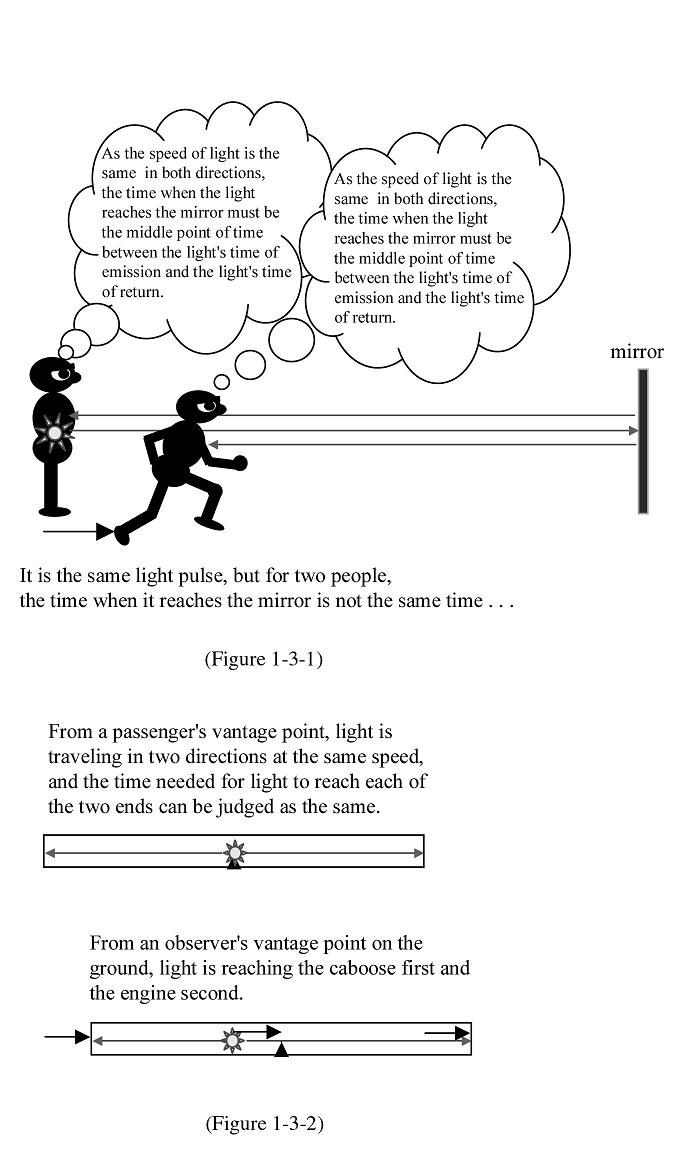A PHILOSOPHY OF THE FOUR-DIMENSIONAL SPACE-TIME
The Worldview of Relative Simultaneity (MURAYAMA Akira)
CHAPTER I
Relativity and Four-dimensional spacetime
[The First half] ---- Outlining the Theory of Relativity ----3. The Relativity of Simultaneity, Time Dilation, and the Length Contraction
(1) The Relativity of Simultaneity
Supposing that the speed of light is consistent in any inertial coordinate system, this means that the simultaneity of two events occurring in two locations is relative and dependent upon a system of coordinates.
Now, imagine a situation in which a particular light pulse is projected away onto a mirror and then reflected back. Let us assume that one person remains at the location of the light source, while a second person runs toward the mirror from the light source, and both observe the same phenomenon. Conventional wisdom would dictate that the second person experiences the light moving relatively more slowly as it travels away, and then more quickly as it returns. However, the principle of light speed invariance maintains that the speed of light for this second person is completely the same in both directions. According to this reasoning, both persons judge that when the light reached the mirror that was the middle point of time between the light's time of emission and the light's time of return. The time when light reached the mirror was not exactly the same for the two persons. (See Figure 1-3-1.)

Figure 1-3-2 illustrates the results Einstein achieved with the following thought experiment on the theory of relativity. First, think about a situation where light is emitted from the center of a locomotive train toward both the engine, at the front, and also toward the caboose, at the back. From a passenger's vantage point, light is traveling in two directions at the same speed, and the time it takes for light to reach each of the two ends can be judged as the same. Next, consider a scenario in which someone is observing the same phenomenon from outside the train. In this second case, light emitted from the center of the train is again traveling both to the front and the back of the train and is traveling in the two directions at the same speed. However, the train's caboose travels toward the light source while the engine is moving away from the light. Therefore, light is, in fact, reaching the caboose first and the engine second. These two timing patterns will differ dependent on the observer's vantage point (the system of coordinates). This logical conclusion is called the relativity of simultaneity.
This relativity of simultaneity is at the very essence of the theory of relativity and is completely compatible with the principle of light speed invariance. The theory of relativity provided early 20th century physicists with an opportunity to discover the concept of the relativity of simultaneity, a radically new idea. In the past, the Copernican theory had once overturned the long-held belief that the earth was absolutely static and that a location existed absolutely at the same spot over a long period of time. In the early 20th century, however, the principle of light speed invariance then overturned the conventionally held belief that the simultaneity of multiple events was absolutely consistent, independent of distance. Just as the concept of a static location is dependent upon a particular velocity of coordinates, simultaneity also hinges on a system of coordinates.